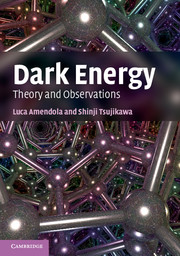Book contents
- Frontmatter
- Contents
- Preface
- List of Frequently used symbols
- 1 Overview
- 2 Expansion history of the Universe
- 3 Correlation function and power spectrum
- 4 Basics of cosmological perturbation theory
- 5 Observational evidence of dark energy
- 6 Cosmological constant
- 7 Dark energy as a modified form of matter I: Quintessence
- 8 Dark energy as a modified form of matter II
- 9 Dark energy as a modification of gravity
- 10 Cosmic acceleration without dark energy
- 11 Dark energy and linear cosmological perturbations
- 12 Non-linear cosmological perturbations
- 13 Statistical methods in cosmology
- 14 Future observational constraints on the nature of dark energy
- 15 Conclusion and outlook
- 16 Answers to the problems
- 17 Mathematical Appendix
- References
- Index
6 - Cosmological constant
Published online by Cambridge University Press: 05 March 2013
- Frontmatter
- Contents
- Preface
- List of Frequently used symbols
- 1 Overview
- 2 Expansion history of the Universe
- 3 Correlation function and power spectrum
- 4 Basics of cosmological perturbation theory
- 5 Observational evidence of dark energy
- 6 Cosmological constant
- 7 Dark energy as a modified form of matter I: Quintessence
- 8 Dark energy as a modified form of matter II
- 9 Dark energy as a modification of gravity
- 10 Cosmic acceleration without dark energy
- 11 Dark energy and linear cosmological perturbations
- 12 Non-linear cosmological perturbations
- 13 Statistical methods in cosmology
- 14 Future observational constraints on the nature of dark energy
- 15 Conclusion and outlook
- 16 Answers to the problems
- 17 Mathematical Appendix
- References
- Index
Summary
The simplest candidate for dark energy is the cosmological constant Λ, which is so called because its energy density is constant in time and space. In fact the ΛCDM model has been systematically proved consistent with a large number of observations. The Lagrangian density for the ΛCDM model is simply given by the linear term in R plus Λ, see Eq. (6.2). Despite its simplicity it is generally difficult to explain why the energy scale of the cosmological constant required for the cosmic acceleration today is very small relative to that predicted by particle physics. As we already mentioned, the vacuum energy density evaluated by summing the zero-point energy of a scalar field is about 10 times larger than the observed dark energy density (for a momentum cut-off around the Planck scale).
The problem of a large value of Λ was present long before the observational discovery of the late-time cosmic acceleration. In fact, even if we had no observational evidence of dark energy we would still need to understand why the cosmological constant vanishes. Models of dark energy alternative to ΛCDM are based on the assumption that Λ is zero or negligible. So the problem of the cosmological constant is to find some mechanism that either makes it vanish or renders it a very small value compatible with the present cosmological density. In the former case the origin of dark energy needs to be explored further, but in the latter case the problems of the cosmological constant and dark energy are solved at the same time.
- Type
- Chapter
- Information
- Dark EnergyTheory and Observations, pp. 109 - 133Publisher: Cambridge University PressPrint publication year: 2010
- 1
- Cited by



